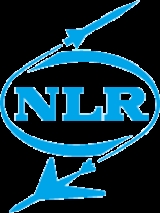
National Aerospace Laboratory
Encyclopedia
The Nationaal Lucht- en Ruimtevaartlaboratorium (NLR) is the National Aerospace Laboratory of the Netherlands
and is one of the Major Technological Institutes of the country. These institutes perform a large part of the applied research in the Netherlands, each within its own specific field of technology. As an independent non-profit organisation, NLR is the central institute
for aerospace research in the Netherlands and provides high-quality technical support to the aerospace sector (NLR is ISO 9001:2000
/AQAP-110 certified).
Work under research contracts (national and international, government and industry) amounts to 75 percent of NLR's activities, the remaining 25 percent is funded by the Dutch government for basic demand-oriented research programmes and development of research equipment. Depending on the project and the customer's preferences, NLR acts as a sole contractor or as a subcontractor co-operating with other institutes or partners from industry.
Research and development work is carried out on a project basis with great synergy between divisions and departments. Strong emphasis is laid on a customer oriented approach.

had nevertheless progressed very rapidly during that period.
Aeronautics developed slowly in the Netherlands during the first two decades of this century when compared to the neighbouring countries, as for example France.
After the Armistice
, 11 November 1918, the aeronautical community started to concentrate on the application of the newly obtained skills and experience. The Government appointed a committee to review the possibilities of aerial applications. The year 1919 saw many new initiatives.
On Saturday 5 April 1919 (when Saturday was a normal working day), the new Laboratory of the RSL was officially opened in the presence of representatives of the Government in a building at the Navy Yard in Amsterdam
. However, at this official opening there was already a laboratory in operation. The laboratory RSL was given an excellent start, although the human and material resources were limited.
In his opening speech Prof. L.A. van Royen emphasized that the RSL should develop free and open communications with the aeronautical world and in turn the RSL should be assisted to come into contact with those who are interested in the activities of RSL. The interested parts should also be able to influence the activities of RSL.
The RSL was originated at offices belonging to the Ministry of Defence mainly as a result of the aviation activities of the Army (since 1913) and the Navy (since 1917). The groundwork for the foundation of RSL started in 1917, in the middle of the First World War, when civil aviation in the Netherlands was non-existent. On 1 January 1920 the RSL was transfer from the Ministry of Defence to the Ministry of Public Works because after the war the defence spending was cut drastically and civil aviation
appeared in the horizon.
As early as 1922, the Minister of Public Works proposed to terminate RSL. The main argument was that the annual funding was considered extravagant. Fortunately nothing happened immediately and the dispute continued for many years.
When in 1918 the RSL was planned, the location at the Navy Yard in Amsterdam was meant as a temporary site only. Prof. van Royen intended to establish a permanent laboratory in Delft, in close association with Delft University of Technology (TU Delft). However, the university apparently was not too eager to accommodate the RSL, probably because of the problems encountered in the 1920s after the RSL became part of the Ministry of Public Works. Also, flight testing had become an important part of the activities and several people felt that a location close to Schiphol and Fokker
was more important than being close to TU Delft.
The RSL essentially developed along the lines as planned during 1918-1919, till it was converted in the independent Foundation NLL in 1937. The only major change in its formal task took place when a separate Department of Civil Aviation (RLD) was created to supervise airworthiness
and aircraft operations in the Netherlands. However this did not have much effect on the technical content of the work of the RSL; it was a separation of responsibilities. This shift of responsibilities was related to the desire of the aircraft industry in the 1930s to have a national laboratory to which all interested parts would have access on an equal basis, according to Ir. A.J. Marx.
The centre piece of the laboratory was an Eiffel type wind tunnel
. The construction of the wind tunnel was complicated because with only limited information available, Dr. Ir. E.B. Wolff managed to produce an operational tunnel by March 1919 and it was shown at the official opening of the RSL.
 The tunnel – essentially a pipe with two open ends – had the air drawn from the room in which the tunnel was placed and it was exhausted into that same room at the other end. It must me assumed that he decided on an Eiffel type tunnel because of the size and limitations of the building and on the results published by Eiffel. Through this arrangement he achieved at least a facility of reasonable size and Reynolds Number. The tunnel had an open test section and, with a maximum power of 30 Horsepower, the mean velocity at the 1.6 meter diameter test section was 25 m/s. However, the uniformity of the flow across the test section was quite unsatisfactory and large fluctuations in time occurred.
The tunnel – essentially a pipe with two open ends – had the air drawn from the room in which the tunnel was placed and it was exhausted into that same room at the other end. It must me assumed that he decided on an Eiffel type tunnel because of the size and limitations of the building and on the results published by Eiffel. Through this arrangement he achieved at least a facility of reasonable size and Reynolds Number. The tunnel had an open test section and, with a maximum power of 30 Horsepower, the mean velocity at the 1.6 meter diameter test section was 25 m/s. However, the uniformity of the flow across the test section was quite unsatisfactory and large fluctuations in time occurred.
After investigations of the flow in the wind tunnel, several modifications were introduced. The result was that by July 1920 a fairly uniform and steady air flow of about 35 m/s in the test section was obtained. This tunnel was used extensively for a period of 20 years for a variety of aeronautical and non-aeronautical tests and, apart from smaller research facilities which were built at TU Delft, it was the only wind tunnel available for aeronautical development in the Netherlands till 1940.
In the meantime Wolff and Koning carried out studies for new wind tunnel facilities. As a result two closed type wind tunnels were built in the new laboratory at Sloterweg in Amsterdam that became fully operational in 1940. One was the LST 3 x 2 m² which was large enough to simulate powered aircraft flight and a smaller, the LST 1.5 x 1.5 m² tunnel for research purposes and non-aeronautical wind tunnel testing. They were the main low speed aerodynamics facilities for over 40 years till the DNW (the joint venture with the German sister organisation DLR
) became operational in 1980, followed by the LST 3 x 2.25 m² of NLR, both in the Noordoostpolder
.
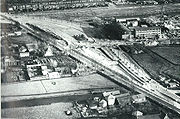 During the five years of the Second World War the total contract work-load of the laboratory decreased dramatically although the personnel increased by 40%. However, it appears that a large number of subjects were studied in depth. When the Allied Forces entered the Netherlands in September 1944 the situation changed very dramatically. The food and fuel supply, already at a bare minimum, practically stopped. Everybody at the laboratory was mentally occupied with the problems of war, survival, food and fuel.
During the five years of the Second World War the total contract work-load of the laboratory decreased dramatically although the personnel increased by 40%. However, it appears that a large number of subjects were studied in depth. When the Allied Forces entered the Netherlands in September 1944 the situation changed very dramatically. The food and fuel supply, already at a bare minimum, practically stopped. Everybody at the laboratory was mentally occupied with the problems of war, survival, food and fuel.
It took several months after the Liberation Day on 5 May 1945 for the normal operations of the laboratory to become re-established. Although the laboratory did not incur physical damage during the war, it was not in good condition after the war. Above that, until 1952 there was a political climate unfavourable to NLL especially in terms of financial support for the expansion plans of the NLL that included a HST, among other facilities.
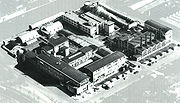 The year 1950 marked the beginning of international co-operation and cross utilisation of facilities between NLL and ONERA. On 23 February 1955 a contract between AICMA-CIPS and NLL was signed which stipulated that NLL would make available the HST to members of AICMA for up to 50% of the available testing time. Later, in 1976, a two-nation aeronautical test facility, the DNW of Germany and the Netherlands, became a reality, and it took until 1988 when finally a four-nation (France, Germany, the UK and the Netherlands) aeronautical test facility, the ETW, was opened.
The year 1950 marked the beginning of international co-operation and cross utilisation of facilities between NLL and ONERA. On 23 February 1955 a contract between AICMA-CIPS and NLL was signed which stipulated that NLL would make available the HST to members of AICMA for up to 50% of the available testing time. Later, in 1976, a two-nation aeronautical test facility, the DNW of Germany and the Netherlands, became a reality, and it took until 1988 when finally a four-nation (France, Germany, the UK and the Netherlands) aeronautical test facility, the ETW, was opened.
In 1957, after a period of deliberations and negotiations, an area of 2 square kilometres was purchased in the Noordoostpolder (NOP). In 1958 the first NLR employees started working there. Since then there has been a gradual shift of activities from Amsterdam the NOP and several buildings were added.
s. Such variety is necessary for ensuring the broad expertise that is needed for coping with the most challenging problems in the aerospace sector.
At its two sites NLR owns several sophisticated aerospace research facilities, including different wind tunnels, such as the Low Speed Wind tunnel, the Transonic and the Supersonic Wind Tunnel. Exploitation of these wind tunnels and the wind tunnels of DLR have been entrusted to the foundation German-Dutch wind tunnels (DNW), which also includes a large facility in the Noordoostpolder in which Germany and the Netherlands have a share of 50%.
(PH-NLZ) and a Cessna Citation II (PH-LAB), the latter shared with Delft University of Technology (TU Delft).
NLR has developed different flight simulators for research on aircraft and helicopters. One of these simulators, the “National Simulation Facility”, is provided for air-to-air and air-to-ground missions with a movement mechanism of six degrees of freedom of the F-16 Cockpit in Mid Life Update configuration for research.
NLR conducts research on future concepts in Air Traffic Management (ATM) and Air Traffic Control (ATC) using its advanced proprietary simulation platform, the NLR ATC Research Simulator (NARSIM). NARSIM consists of two physical instantiations, one for en-route ATC (NARSIM-Radar) and one for airport tower controllers (NARSIM-Tower) with a 360-degrees field-of-view visual system. NARSIM is also used for performance of technology verification and validation activities as well as air traffic controller training.
NLR has installations in which airplane constructions on full scale, components and test samples can be tested. Equipment and software for development of construction of parts for airplanes and space vehicles are also available. For development and construction of composites a special laboratory has been arranged. Moreover the NLR has instrumentation for flight tests, and several specialized apparatus for development of avionics. Facilities for testing antenna and conduction of so-called environmental tests are used to test several equipments. In the micromechanics workplace the NLR develops models and instruments for wind tunnel tests. The computer network of the NLR contains a supercomputer for the implementation of extensive aerodynamic and structural calculations.
CIPS = Comité Internationale Permanent des Souffleries (Permanent Committee on Wind Tunnels)
DLR = Deutsches Zentrum für Luft- und Raumfahrt (German Aerospace Centre)
DNW = Deutsch-Niederländischer Windkanal / Duits-Nederlandse Windtunnel (German-Dutch Wind Tunnel)
ETW = European Transonic Wind Tunnel
HST = High Speed Wind Tunnel
LST = Low Speed Wind Tunnel
MRO = Maintenance, Repair and Overhaul
NLL = Nationaal Luchtvaartlaboratorium (National Aeronautical Laboratory)
ONERA = Office National d’Études et de R'echerches Aéronautiques (French Aeronautical Research Organization)
RLD = Rijksluchtvaartdienst (Government Department of Civil Aviation)
RSL = Rijks-Studiedienst voor de Luchtvaart (Government Service for Aeronautical Studies)
Netherlands
The Netherlands is a constituent country of the Kingdom of the Netherlands, located mainly in North-West Europe and with several islands in the Caribbean. Mainland Netherlands borders the North Sea to the north and west, Belgium to the south, and Germany to the east, and shares maritime borders...
and is one of the Major Technological Institutes of the country. These institutes perform a large part of the applied research in the Netherlands, each within its own specific field of technology. As an independent non-profit organisation, NLR is the central institute
Institute
An institute is a permanent organizational body created for a certain purpose. Often it is a research organization created to do research on specific topics...
for aerospace research in the Netherlands and provides high-quality technical support to the aerospace sector (NLR is ISO 9001:2000
ISO 9000
The ISO 9000 family of standards relates to quality management systems and is designed to help organizations ensure they meet the needs of customers and other stakeholders . The standards are published by ISO, the International Organization for Standardization, and available through National...
/AQAP-110 certified).
Organisation
NLR's activities are market-oriented, independent, socially relevant and without profit priority. By acting so, NLR can adequately respond to the need for scientific knowledge and technology in the field of aviation and space travel, which arises from the government, public and industry. Thus being the natural partner for aerospace research.Work under research contracts (national and international, government and industry) amounts to 75 percent of NLR's activities, the remaining 25 percent is funded by the Dutch government for basic demand-oriented research programmes and development of research equipment. Depending on the project and the customer's preferences, NLR acts as a sole contractor or as a subcontractor co-operating with other institutes or partners from industry.
Research and development work is carried out on a project basis with great synergy between divisions and departments. Strong emphasis is laid on a customer oriented approach.
NLR's position in the Netherlands and the World

History
The RSL, the predecessor of NLR, was officially founded on 5 April 1919, shortly after the First World War. Although air power did not play a decisive role during this war, aeronauticsAeronautics
Aeronautics is the science involved with the study, design, and manufacturing of airflight-capable machines, or the techniques of operating aircraft and rocketry within the atmosphere...
had nevertheless progressed very rapidly during that period.
Aeronautics developed slowly in the Netherlands during the first two decades of this century when compared to the neighbouring countries, as for example France.
After the Armistice
Armistice
An armistice is a situation in a war where the warring parties agree to stop fighting. It is not necessarily the end of a war, but may be just a cessation of hostilities while an attempt is made to negotiate a lasting peace...
, 11 November 1918, the aeronautical community started to concentrate on the application of the newly obtained skills and experience. The Government appointed a committee to review the possibilities of aerial applications. The year 1919 saw many new initiatives.
On Saturday 5 April 1919 (when Saturday was a normal working day), the new Laboratory of the RSL was officially opened in the presence of representatives of the Government in a building at the Navy Yard in Amsterdam
Amsterdam
Amsterdam is the largest city and the capital of the Netherlands. The current position of Amsterdam as capital city of the Kingdom of the Netherlands is governed by the constitution of August 24, 1815 and its successors. Amsterdam has a population of 783,364 within city limits, an urban population...
. However, at this official opening there was already a laboratory in operation. The laboratory RSL was given an excellent start, although the human and material resources were limited.
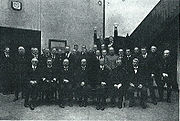 |
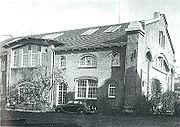 |
In his opening speech Prof. L.A. van Royen emphasized that the RSL should develop free and open communications with the aeronautical world and in turn the RSL should be assisted to come into contact with those who are interested in the activities of RSL. The interested parts should also be able to influence the activities of RSL.
The RSL was originated at offices belonging to the Ministry of Defence mainly as a result of the aviation activities of the Army (since 1913) and the Navy (since 1917). The groundwork for the foundation of RSL started in 1917, in the middle of the First World War, when civil aviation in the Netherlands was non-existent. On 1 January 1920 the RSL was transfer from the Ministry of Defence to the Ministry of Public Works because after the war the defence spending was cut drastically and civil aviation
Civil aviation
Civil aviation is one of two major categories of flying, representing all non-military aviation, both private and commercial. Most of the countries in the world are members of the International Civil Aviation Organization and work together to establish common standards and recommended practices...
appeared in the horizon.
As early as 1922, the Minister of Public Works proposed to terminate RSL. The main argument was that the annual funding was considered extravagant. Fortunately nothing happened immediately and the dispute continued for many years.
When in 1918 the RSL was planned, the location at the Navy Yard in Amsterdam was meant as a temporary site only. Prof. van Royen intended to establish a permanent laboratory in Delft, in close association with Delft University of Technology (TU Delft). However, the university apparently was not too eager to accommodate the RSL, probably because of the problems encountered in the 1920s after the RSL became part of the Ministry of Public Works. Also, flight testing had become an important part of the activities and several people felt that a location close to Schiphol and Fokker
Fokker
Fokker was a Dutch aircraft manufacturer named after its founder, Anthony Fokker. The company operated under several different names, starting out in 1912 in Schwerin, Germany, moving to the Netherlands in 1919....
was more important than being close to TU Delft.
The RSL essentially developed along the lines as planned during 1918-1919, till it was converted in the independent Foundation NLL in 1937. The only major change in its formal task took place when a separate Department of Civil Aviation (RLD) was created to supervise airworthiness
Airworthiness
Airworthiness is a term used to describe whether an aircraft has been certified as suitable for safe flight. Certification is initially conferred by a Certificate of Airworthiness from a National Airworthiness Authority, and is maintained by performing required maintenance actions by a licensed...
and aircraft operations in the Netherlands. However this did not have much effect on the technical content of the work of the RSL; it was a separation of responsibilities. This shift of responsibilities was related to the desire of the aircraft industry in the 1930s to have a national laboratory to which all interested parts would have access on an equal basis, according to Ir. A.J. Marx.
The centre piece of the laboratory was an Eiffel type wind tunnel
Wind tunnel
A wind tunnel is a research tool used in aerodynamic research to study the effects of air moving past solid objects.-Theory of operation:Wind tunnels were first proposed as a means of studying vehicles in free flight...
. The construction of the wind tunnel was complicated because with only limited information available, Dr. Ir. E.B. Wolff managed to produce an operational tunnel by March 1919 and it was shown at the official opening of the RSL.

After investigations of the flow in the wind tunnel, several modifications were introduced. The result was that by July 1920 a fairly uniform and steady air flow of about 35 m/s in the test section was obtained. This tunnel was used extensively for a period of 20 years for a variety of aeronautical and non-aeronautical tests and, apart from smaller research facilities which were built at TU Delft, it was the only wind tunnel available for aeronautical development in the Netherlands till 1940.
In the meantime Wolff and Koning carried out studies for new wind tunnel facilities. As a result two closed type wind tunnels were built in the new laboratory at Sloterweg in Amsterdam that became fully operational in 1940. One was the LST 3 x 2 m² which was large enough to simulate powered aircraft flight and a smaller, the LST 1.5 x 1.5 m² tunnel for research purposes and non-aeronautical wind tunnel testing. They were the main low speed aerodynamics facilities for over 40 years till the DNW (the joint venture with the German sister organisation DLR
German Aerospace Center
The German Aerospace Center is the national centre for aerospace, energy and transportation research of the Federal Republic of Germany. It has multiple locations throughout Germany. Its headquarters are located in Cologne. It is engaged in a wide range of research and development projects in...
) became operational in 1980, followed by the LST 3 x 2.25 m² of NLR, both in the Noordoostpolder
Noordoostpolder
Noordoostpolder is a municipality in the Flevoland province in the central Netherlands. Formerly, it was also called Urker Land. Emmeloord is the administrative center, located in the heart of the Noordoostpolder. The municipality has the largest land area in the Netherlands...
.

It took several months after the Liberation Day on 5 May 1945 for the normal operations of the laboratory to become re-established. Although the laboratory did not incur physical damage during the war, it was not in good condition after the war. Above that, until 1952 there was a political climate unfavourable to NLL especially in terms of financial support for the expansion plans of the NLL that included a HST, among other facilities.

In 1957, after a period of deliberations and negotiations, an area of 2 square kilometres was purchased in the Noordoostpolder (NOP). In 1958 the first NLR employees started working there. Since then there has been a gradual shift of activities from Amsterdam the NOP and several buildings were added.
Aerospace Systems and Applications (AS&A)
- The division of AS&A identifies and develops required technology and knowledge and applies it on the development of innovative aerospace travel systems.
- The emphasis lies on the operational commitment of aerospace travel systems at improving the effectiveness and the efficiency of Dutch military aviationMilitary aviationMilitary aviation is the use of aircraft and other flying machines for the purposes of conducting or enabling warfare, including national airlift capacity to provide logistical supply to forces stationed in a theater or along a front. Air power includes the national means of conducting such...
, particularly at the purchase and introduction of new material and systems. - The objective of the AS&A division of the NLR is - in close co-operation with aerospace travel stakeholders - to identify their needs and translate those needs into (technical) solutions in order to reinforce the position of the stakeholders.
Air Transport (AT)
- The AT division, as part of NLR's aerospace activities, concentrates on identifying, developing and making applicable the technology and knowledge for safe, efficient and socially acceptable aircraft usage, airspace and airportAirportAn airport is a location where aircraft such as fixed-wing aircraft, helicopters, and blimps take off and land. Aircraft may be stored or maintained at an airport...
exploitation. - The AT division strives for close co-operation with several players in the aviation sector in order to identify and translate the needs of the sector into (technology) solutions for today and for the future.
- The AT division, by means of national and international co-operation and a strong internal synergy with the AV and AS divisions, aims to reinforce the social and market relevance of the NLR. The AT division sees itself at the top three of similar European research institutions.
- The AT division offers an ongoing professional challenge to its staff by means of its activities, career prospect and (professional) surroundings. Expertise, result and customer orientation is characteristic of NLR. By means of authoritative research and test facilities the AT division ensures the integrity of its results.
- NLR opened the NLR Air Transport Safety InstituteNLR Air Transport Safety InstituteThe NLR Air Transport Safety Institute is a research and consultancy organisation embedded in the National Aerospace Laboratory of the Netherlands . NLR-ATSI is one of the largest institutes of its kind in Europe. The institute was officially opened by Prof. Pieter van Vollenhoven on October 31,...
(NLR-ATSI) on October 31, 2007. This institute conducts research to improve the safety and efficiency of air transport.
Aerospace Vehicles (AV)
- The AV division identifies, researches, develops, provides and spreads high-quality knowledge, technology and services in the fields of design, certification, development, use and maintenance of aerospace vehicles. It supports air/space travel policy, defence policy and the economic policy of the government, and reinforces the international competitive position of the aircraft industry, MRO companies and engineering offices.
- The AV division realises the national ambition of NLR within an international network of institutes and companies, high-quality knowledge concerning aerospace vehicles to gather and develop new products.
- The AV division offers provocative work surroundings for its employees, with attention to career prospect.
- The AV division's employees have information about customers, stakeholders and international markets in which they are active. They have the necessary knowledge to anticipate on the questions of customers and have a customer-specific attitude.
Sites
A staff of approximately 700 people is employed at two sites, one located in Amsterdam, and the other in Noordoostpolder (a region about 100 km north-east of Amsterdam). Over two-thirds of the staff are graduates from universities or technical colleges, with a large variety in specialised professions such as aerospace engineers, psychologists, mathematicians and physicistPhysicist
A physicist is a scientist who studies or practices physics. Physicists study a wide range of physical phenomena in many branches of physics spanning all length scales: from sub-atomic particles of which all ordinary matter is made to the behavior of the material Universe as a whole...
s. Such variety is necessary for ensuring the broad expertise that is needed for coping with the most challenging problems in the aerospace sector.
At its two sites NLR owns several sophisticated aerospace research facilities, including different wind tunnels, such as the Low Speed Wind tunnel, the Transonic and the Supersonic Wind Tunnel. Exploitation of these wind tunnels and the wind tunnels of DLR have been entrusted to the foundation German-Dutch wind tunnels (DNW), which also includes a large facility in the Noordoostpolder in which Germany and the Netherlands have a share of 50%.
Facilities
NLR has two laboratory airplanes, a Fairchild Metro IIFairchild Swearingen Metroliner
The Fairchild Swearingen Metroliner or the Fairchild Aerospace Metro is a 19-seat, pressurised, twin turboprop airliner first produced by Swearingen Aircraft and later by Fairchild at a plant in San Antonio, Texas, United States....
(PH-NLZ) and a Cessna Citation II (PH-LAB), the latter shared with Delft University of Technology (TU Delft).
 |
 |
NLR has developed different flight simulators for research on aircraft and helicopters. One of these simulators, the “National Simulation Facility”, is provided for air-to-air and air-to-ground missions with a movement mechanism of six degrees of freedom of the F-16 Cockpit in Mid Life Update configuration for research.
NLR conducts research on future concepts in Air Traffic Management (ATM) and Air Traffic Control (ATC) using its advanced proprietary simulation platform, the NLR ATC Research Simulator (NARSIM). NARSIM consists of two physical instantiations, one for en-route ATC (NARSIM-Radar) and one for airport tower controllers (NARSIM-Tower) with a 360-degrees field-of-view visual system. NARSIM is also used for performance of technology verification and validation activities as well as air traffic controller training.
NLR has installations in which airplane constructions on full scale, components and test samples can be tested. Equipment and software for development of construction of parts for airplanes and space vehicles are also available. For development and construction of composites a special laboratory has been arranged. Moreover the NLR has instrumentation for flight tests, and several specialized apparatus for development of avionics. Facilities for testing antenna and conduction of so-called environmental tests are used to test several equipments. In the micromechanics workplace the NLR develops models and instruments for wind tunnel tests. The computer network of the NLR contains a supercomputer for the implementation of extensive aerodynamic and structural calculations.
List of abbreviations
AICMA = Association Internationale des Constructeurs de Matérial Aéronautique (European Association of Aircraft Manufacturers)CIPS = Comité Internationale Permanent des Souffleries (Permanent Committee on Wind Tunnels)
DLR = Deutsches Zentrum für Luft- und Raumfahrt (German Aerospace Centre)
DNW = Deutsch-Niederländischer Windkanal / Duits-Nederlandse Windtunnel (German-Dutch Wind Tunnel)
ETW = European Transonic Wind Tunnel
HST = High Speed Wind Tunnel
LST = Low Speed Wind Tunnel
MRO = Maintenance, Repair and Overhaul
NLL = Nationaal Luchtvaartlaboratorium (National Aeronautical Laboratory)
ONERA = Office National d’Études et de R'echerches Aéronautiques (French Aeronautical Research Organization)
RLD = Rijksluchtvaartdienst (Government Department of Civil Aviation)
RSL = Rijks-Studiedienst voor de Luchtvaart (Government Service for Aeronautical Studies)
External links
- NLR Home Page
- NLR Video Clips
- NLR Publications
- NARSIM - Air Traffic Simulations
- NLR Air Transport Safety Institute

